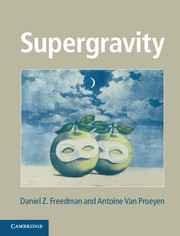Book contents
- Frontmatter
- Contents
- Preface
- Acknowledgements
- Introduction
- Part I Relativistic field theory in Minkowski spacetime
- Part II Differential geometry and gravity
- Part III Basic supergravity
- Part IV Complex geometry and global SUSY
- Part V Superconformal construction of supergravity theories
- Part VI N = 1 supergravity actions and applications
- Part VII Extended N = 2 supergravity
- Part VIII Classical solutions and the AdS/CFT correspondence
- Appendix A Comparison of notation
- Appendix B Lie algebras and superalgebras
- References
- Index
Introduction
Published online by Cambridge University Press: 05 May 2012
- Frontmatter
- Contents
- Preface
- Acknowledgements
- Introduction
- Part I Relativistic field theory in Minkowski spacetime
- Part II Differential geometry and gravity
- Part III Basic supergravity
- Part IV Complex geometry and global SUSY
- Part V Superconformal construction of supergravity theories
- Part VI N = 1 supergravity actions and applications
- Part VII Extended N = 2 supergravity
- Part VIII Classical solutions and the AdS/CFT correspondence
- Appendix A Comparison of notation
- Appendix B Lie algebras and superalgebras
- References
- Index
Summary
Two developments in the late 1960s and early 1970s set the stage for supergravity. First the standard model took shape and was decisively confirmed by experiments. The key theoretical concept underlying this progress was gauge symmetry, the idea that symmetry transformations act independently at each point of spacetime. In the standard model these are internal symmetries, whose parameters are Lorentz scalars θA (x) that are arbitrary functions of the spacetime point x. These parameters are coordinates of the compact Lie group SU(3) ⊗ SU(2) ⊗ U(1). Scalar, spinor, and vector fields of the theory are each classified in representations of this group, and the Lagrangian is invariant under group transformations. The special dynamics associated with the non-abelian gauge principle allows different realizations of the symmetry in the particle spectrum and interactions that would be observed in experiments. For example, part of the gauge symmetry may be ‘spontaneously broken’. In the standard model this produces the ‘unification’ of weak and electromagnetic interactions. The observed strength and range of these forces are very different, yet the gauge symmetry gives them a common origin.
The other development was global (also called rigid) supersymmetry [1, 2, 3]. It is the unique framework that allows fields and particles of different spin to be unified in representations of an algebraic system called a superalgebra. The symmetry parameters are spinors ϵα that are constant, independent of x. The simplest N = 1 superalgebra contains a spinor supercharge Qα and the energy–momentum operator Pa. The anti-commutator of two supercharges is a translation in spacetime.
- Type
- Chapter
- Information
- Supergravity , pp. 1 - 4Publisher: Cambridge University PressPrint publication year: 2012
- 1
- Cited by



